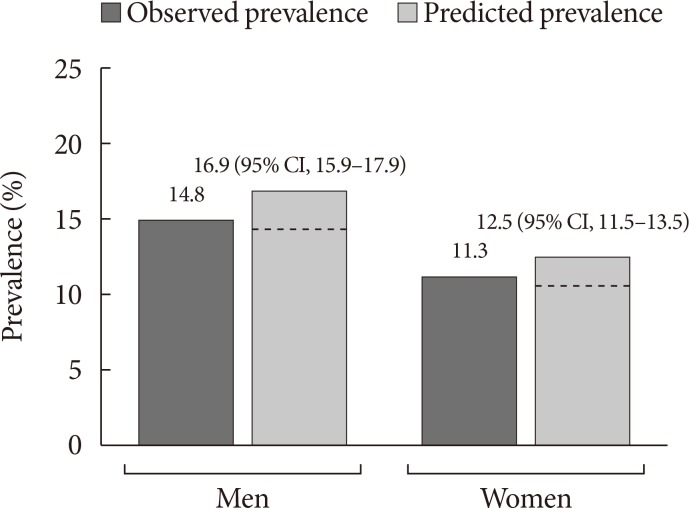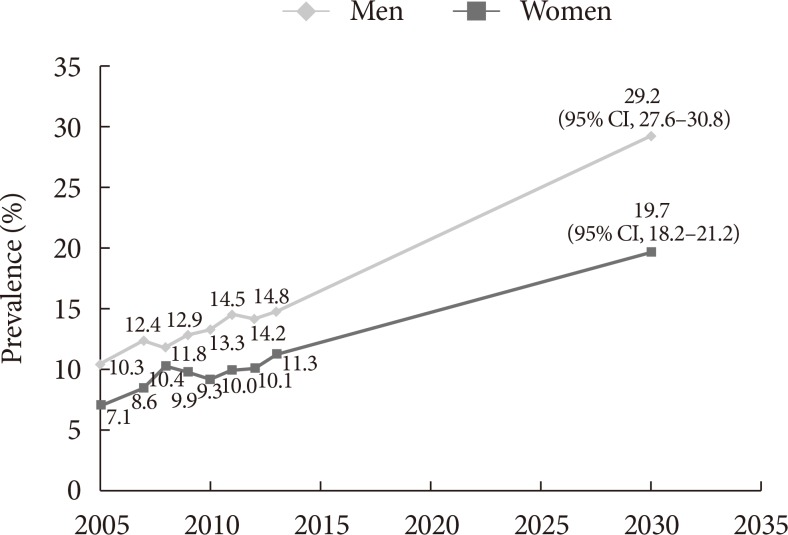Diabetes Metab J.
2019 Feb;43(1):90-96. 10.4093/dmj.2018.0043.
Projection of Diabetes Prevalence in Korean Adults for the Year 2030 Using Risk Factors Identified from National Data
- Affiliations
-
- 1Department of Foods and Nutrition, College of Science and Technology, Kookmin University, Seoul, Korea. ibaik@kookmin.ac.kr
- KMID: 2460975
- DOI: http://doi.org/10.4093/dmj.2018.0043
Abstract
- BACKGROUND
A number of studies have reported future prevalence estimates for diabetes mellitus (DM), but these studies have been limited for the Korean population. The present study aimed to construct a forecasting model that includes risk factors for type 2 DM using individual- and national-level data for Korean adults to produce prevalence estimates for the year 2030.
METHODS
Time series data from the Korea National Health and Nutrition Examination Survey and national statistics from 2005 to 2013 were used. The study subjects were 13,908 male and 18,697 female adults aged 30 years or older who were free of liver cirrhosis. Stepwise logistic regression analysis was used to select significant factors associated with DM prevalence.
RESULTS
The results showed that survey year, age, sex, marital, educational, or occupational status, the presence of obesity or hypertension, smoking status, alcohol consumption, sleep duration, psychological distress or depression, and fertility rate significantly contributed to the 8-year trend in DM prevalence (P < 0.05). Based on sex-specific forecasting models that included the above factors, DM prevalence for the year 2030 was predicted to be 29.2% (95% confidence interval [CI], 27.6% to 30.8%) in men and 19.7% (95% CI, 18.2% to 21.2%) in women.
CONCLUSION
The present study projected a two-fold increase in the prevalence of DM in 2030 compared with that for the years 2013 and 2014 in Korean adults. Modifiable factors contributing to this increase in DM prevalence, such as obesity, smoking, and psychological factors, may require attention in order to reduce national and individual costs associated with DM.
Keyword
MeSH Terms
Figure
Cited by 2 articles
-
Smoking as a Target for Prevention of Diabetes
Ye Seul Yang, Tae Seo Sohn
Diabetes Metab J. 2020;44(3):402-404. doi: 10.4093/dmj.2020.0126.Spironolactone Attenuates Methylglyoxal-induced Cellular Dysfunction in MC3T3-E1 Osteoblastic Cells
So Young Park, Kwang Sik Suh, Woon-Won Jung, Sang Ouk Chin
J Korean Med Sci. 2021;36(38):e265. doi: 10.3346/jkms.2021.36.e265.
Reference
-
1. World Health Organization. Global report on diabetes. Geneva: World Health Organization;2016.2. Ministry of Health and Welfare, Korea Centers for Disease Control and Prevention. Korea health statistics 2015: Korea National Health and Nutrition Examination Survey (KNHANES VI-3). Sejong: Korea Centers for Disease Control and Prevention;2016.3. National Statistics Office. Population projections for Korea: 2015-2065. Seoul: Government of Korea;2016.4. Whiting DR, Guariguata L, Weil C, Shaw J. IDF diabetes atlas: global estimates of the prevalence of diabetes for 2011 and 2030. Diabetes Res Clin Pract. 2011; 94:311–321. PMID: 22079683.
Article5. Brinks R, Tamayo T, Kowall B, Rathmann W. Prevalence of type 2 diabetes in Germany in 2040: estimates from an epidemiological model. Eur J Epidemiol. 2012; 27:791–797. PMID: 22878939.
Article6. Javanbakht M, Mashayekhi A, Baradaran HR, Haghdoost A, Afshin A. Projection of diabetes population size and associated economic burden through 2030 in Iran: evidence from micro-simulation Markov model and Bayesian meta-analysis. PLoS One. 2015; 10:e0132505. PMID: 26200913.
Article7. Andersson T, Ahlbom A, Carlsson S. Diabetes prevalence in Sweden at present and projections for year 2050. PLoS One. 2015; 10:e0143084. PMID: 26619340.
Article8. Sozmen K, Unal B, Capewell S, Critchley J, O'Flaherty M. Estimating diabetes prevalence in Turkey in 2025 with and without possible interventions to reduce obesity and smoking prevalence, using a modelling approach. Int J Public Health. 2015; 60(Suppl 1):S13–S21. PMID: 25471076.
Article9. Holman N, Forouhi NG, Goyder E, Wild SH. The Association of Public Health Observatories (APHO) diabetes prevalence model: estimates of total diabetes prevalence for England, 2010-2030. Diabet Med. 2011; 28:575–582. PMID: 21480968.
Article10. Honeycutt AA, Boyle JP, Broglio KR, Thompson TJ, Hoerger TJ, Geiss LS, Narayan KM. A dynamic Markov model for forecasting diabetes prevalence in the United States through 2050. Health Care Manag Sci. 2003; 6:155–164. PMID: 12943151.11. Gregg EW, Boyle JP, Thompson TJ, Barker LE, Albright AL, Williamson DF. Modeling the impact of prevention policies on future diabetes prevalence in the United States: 2010-2030. Popul Health Metr. 2013; 11:18. PMID: 24047329.
Article12. Boyle JP, Thompson TJ, Gregg EW, Barker LE, Williamson DF. Projection of the year 2050 burden of diabetes in the US adult population: dynamic modeling of incidence, mortality, and prediabetes prevalence. Popul Health Metr. 2010; 8:29. PMID: 20969750.
Article13. Wang Y, Beydoun MA, Liang L, Caballero B, Kumanyika SK. Will all Americans become overweight or obese? Estimating the progression and cost of the US obesity epidemic. Obesity (Silver Spring). 2008; 16:2323–2330. PMID: 18719634.
Article14. Maddams J, Utley M, Moller H. Projections of cancer prevalence in the United Kingdom, 2010-2040. Br J Cancer. 2012; 107:1195–1202. PMID: 22892390.
Article15. Brookmeyer R, Abdalla N, Kawas CH, Corrada MM. Forecasting the prevalence of preclinical and clinical Alzheimer's disease in the United States. Alzheimers Dement. 2018; 14:121–129. PMID: 29233480.
Article16. Finkelstein EA, Khavjou OA, Thompson H, Trogdon JG, Pan L, Sherry B, Dietz W. Obesity and severe obesity forecasts through 2030. Am J Prev Med. 2012; 42:563–570. PMID: 22608371.
Article17. National Statistics Office. Population projections for Korea: 2010-2060. Seoul: Government of Korea;2011.18. Korean Diabetes Association. Diabetes fact sheet in Korea 2016. Seoul: Korean Diabetes Association;2016.19. Koska J, Stefan N, Votruba SB, Smith SR, Krakoff J, Bunt JC. Distribution of subcutaneous fat predicts insulin action in obesity in sex-specific manner. Obesity (Silver Spring). 2008; 16:2003–2009. PMID: 18551127.
Article20. Asia Pacific Cohort Studies Collaboration. Ni Mhurchu C, Parag V, Nakamura M, Patel A, Rodgers A, Lam TH. Body mass index and risk of diabetes mellitus in the Asia-Pacific region. Asia Pac J Clin Nutr. 2006; 15:127–133. PMID: 16672195.21. Willi C, Bodenmann P, Ghali WA, Faris PD, Cornuz J. Active smoking and the risk of type 2 diabetes: a systematic review and meta-analysis. JAMA. 2007; 298:2654–2664. PMID: 18073361.22. Cappuccio FP, D'Elia L, Strazzullo P, Miller MA. Quantity and quality of sleep and incidence of type 2 diabetes: a systematic review and meta-analysis. Diabetes Care. 2010; 33:414–420. PMID: 19910503.23. Yu M, Zhang X, Lu F, Fang L. Depression and risk for diabetes: a meta-analysis. Can J Diabetes. 2015; 39:266–272. PMID: 25773933.
Article24. Sui H, Sun N, Zhan L, Lu X, Chen T, Mao X. Association between work-related stress and risk for type 2 diabetes: a systematic review and meta-analysis of prospective cohort studies. PLoS One. 2016; 11:e0159978. PMID: 27513574.
Article25. Koppes LL, Dekker JM, Hendriks HF, Bouter LM, Heine RJ. Moderate alcohol consumption lowers the risk of type 2 diabetes: a meta-analysis of prospective observational studies. Diabetes Care. 2005; 28:719–725. PMID: 15735217.
- Full Text Links
- Actions
-
Cited
- CITED
-
- Close
- Share
- Similar articles
-
- Response: Projection of Diabetes Prevalence in Korean Adults for the Year 2030 Using Risk Factors Identified from National Data (Diabetes Metab J 2019;43:90–6)
- Letter: Projection of Diabetes Prevalence in Korean Adults for the Year 2030 Using Risk Factors Identified from National Data (Diabetes Metab J 2019;43:90–6)
- Forecasting obesity prevalence in Korean adults for the years 2020 and 2030 by the analysis of contributing factors
- Trend Analysis in the Prevalence of Type 2 Diabetes According to Risk Factors among Korean Adults: Based on the 2001~2009 Korean National Health and Nutrition Examination Survey Data
- The Epidemiology of Diabetes in Korea



